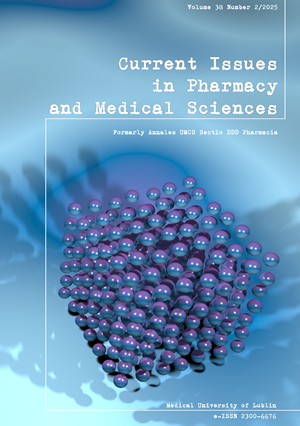Harnessing machine learning for predictive pharmacokinetics: revolutionizing drug development and personalized medicine
DOI:
https://doi.org/10.12923/cipms-2025-0020Keywords:
absorption, distribution, metabolism, excretion (ADME), machine learning (ML), pharmacokinetics (PK)Abstract
Despite extensive existing literature on the role of machine learning (ML) in pharmacokinetics and drug development, there remains a gap in understanding its real-world implementation challenges, especially across diverse populations. This review aims to bridge this gap by focusing on specific case studies that illustrate the practical impact of ML on addressing the limitations of traditional pharmacokinetic (PK) methods. By leveraging large datasets and sophisticated algorithms, ML techniques provide improved predictions of absorption, distribution, metabolism, and excretion (ADME) processes, offering an individualized approach to patient care. Unlike traditional PK modeling, ML allows for the handling of large-scale, multidimensional data, improving the prediction accuracy for diverse patient populations. This review delves into recent advancements in ML applications for PK, emphasizing their impact on early-stage drug discovery, dose optimization, and tailoring personalized treatment plans. Specific case studies illustrate the advantages of ML over conventional approaches, particularly in addressing the variability in drug responses among patients. The challenges and opportunities of using ML in PK modeling are discussed, highlighting the potential of these techniques to revolutionize pharmaceutical sciences.
References
1. Chou WC, Lin Z. Machine learning and artificial intelligence in physiologically based pharmacokinetic modeling. Toxicol Sci. 2022;191(1):1-14.
2. Janssen A, Bennis FC, Mathôt RAA. Adoption of machine learning in pharmacometrics: An overview of recent implementations and their considerations. Pharmaceutics. 2022;14(9):1814. https://doi.org/10.3390/pharmaceutics14091814
3. McComb M, Bies R, Ramanathan M. Machine learning in pharmacometrics: Opportunities and challenges. Br J Clin Pharmacol. 2021.
4. Terranova N, Venkatakrishnan K, Benincosa LJ. Application of machine learning in translational medicine: Current status and future opportunities. AAPS J. 2021;23:4. https://doi.org/10.1208/s12248-021-00593-x
5. Pawar V, Patil A, Tamboli F, Gaikwad D, Mali D, Shinde A. Harnessing the power of AI in Pharmacokinetics and Pharmacodynamics: A comprehensive review. Int J Pharm Qual Assur. 2023;14(2):426-39. https://doi.org/10.25258/ijpqa.14.2.31
6. Sahu M, Gupta R, Ambasta RK, Kumar P. Artificial intelligence and machine learning in precision medicine: A paradigm shift in big data analysis. In: D. B. Teplow (ed). Science Direct Academic Press; 2022. https://doi.org/10.1016/bs.pmbts.2022.03.002
7. McCoubrey LE, Elbadawi M, Orlu M, Gaisford S, Basit AW. Harnessing machine learning for the development of microbiome therapeutics. Gut Microbes. 2021;13(1):1-20. https://doi.org/10.1080/19490976.2021.1872323
8. Koch G, Pfister M, Daunhawer I, Wilbaux M, Wellmann S, Vogt JE. Pharmacometrics and machine learning partner to advance clinical data analysis. Clin Pharmacol Ther. 2020;107:926-33. https://doi.org/10.1002/cpt.1774
9. Vora LK, Gholap AD, Jetha K, Thakur RRS, Solanki HK, Chavda VP. Artificial intelligence in pharmaceutical technology and drug delivery design. Pharmaceutics. 2023;15(7):1916. https://doi.org/10.3390/pharmaceutics15071916
10. Sherer EA, Sale ME, Pollock BG, Belani C, Egorin MJ, Ivy PS, et al. Application of a single-objective, hybrid genetic algorithm approach to pharmacokinetic model building. J Pharmacokinet Pharmacodyn. 2012;39:393-414. https://doi.org/10.1007/s10928-012-9258-0
11. Bies RR, Muldoon MF, Pollock BG, Manuck S, Smith G, Sale ME. A Genetic algorithm-based, hybrid machine learning approach to model selection. J Pharmacokinet.Pharmacodyn. 2006;33:195-221. https://doi.org/10.1007/s10928-006-9004-6
12. Simonsson USH, You H, Farnoud A, Nyberg J, Wicha SG, Maher-Edwards G, et al. Machine learning and pharmacometrics for prediction of pharmacokinetic data: Differences, similarities and challenges illustrated with rifampicin. Pharmaceutics. 2022;14(8):1530. https://doi.org/10.3390/pharmaceutics14081530
13. Janssen A, Leebeek F, Cnossen H, Mathôt R. The neural mixed effects algorithm: leveraging machine learning for pharmacokinetic modelling. [https://www.page-meeting.org/?abstract=9826] (accessed: 10 Jul 2024).
Downloads
Published
Issue
Section
License
Copyright (c) 2025 Author

This work is licensed under a Creative Commons Attribution-NonCommercial-NoDerivatives 3.0 Unported License.


